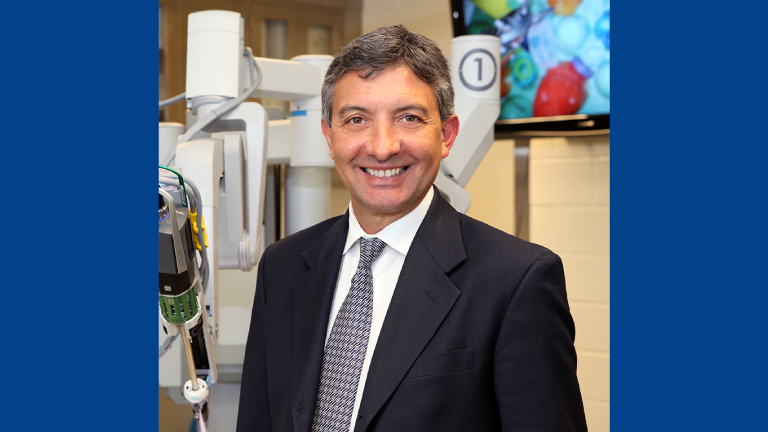Enrico is a transplant surgeon at UI Health.
Tell us about your organization and the work you do there.
The University of Illinois Hospital & Health Sciences System (UI Health) provides comprehensive care, education, and research to the people of Illinois and beyond. As part of the University of Illinois at Chicago (UIC), UI Health comprises a clinical enterprise that includes a 450-bed tertiary care hospital, 21 outpatient clinics, and 14 Mile Square Health Center facilities, which are Federally Qualified Health Centers. It also includes the seven UIC health science colleges. UI Health is one of Chicago’s leading healthcare providers and is dedicated to the pursuit of health equity.
What communities do you serve?
UI Health serves residents of the state of Illinois, primarily those living in Chicago. Our primary service areas include 56 ZIP codes and 56 community areas around Chicago, the majority of which are on the city’s diverse South and West sides.
What populations do you serve?
The majority of the population in our service area identify as part of a minority racial or ethnic group. A large percentage of our patients are covered by Medicaid and our community-based clinics care for patients regardless of insurance status or ability to pay.
Why did you decide to join the Illinois Kidney Care Alliance?
As the director of a large kidney and pancreas transplant program in Chicago, I am very interested in any initiative taken to support this high-risk patient population. Since our transplant patients at UI Health are mostly members of underrepresented minorities (55% African Americans and 30% Latinx), I deeply appreciated the numerous initiatives promoted by IKCA on behalf of these populations.
What do you hope the alliance accomplishes?
I hope that this committed group of individuals and organizations who are deeply concerned about the care of patients with chronic kidney disease (both during dialysis and in relation to transplantation) will continuously remind legislators and administrative leaders of the importance and critical nature of the problem. Because of the complexity of medical care, its enormous cost to society, and most importantly, the high risk of premature deaths in ESRD patients, the state of Illinois should have a continuous focus on any possible improvement in care.
What policy changes do those living with kidney disease need now?
The medical literature has clearly demonstrated that kidney transplantation greatly improves the survival of ESRD patients when compared to dialysis and ensures a better quality of life. Every effort should be made to increase the transplant rates in Illinois and the key is proper information at the level of the dialysis center. In Illinois, the overwhelming majority of nephrologists are incredibly supportive of kidney transplantation but patients tend to receive information from a variety of members of the staff of the dialysis unit. A policy mandating standard, pro transplant, information could go long way. Specific attention should be directed to provide information regarding the specific merits of living donor kidney transplantation, in relation to superior outcomes and timely treatment.
What can lawmakers do to help those with kidney disease?
Illinois lawmakers have demonstrated special sensitivity to the problem of the dialysis population. Recently, the only legislation in the country providing support for kidney transplantation to undocumented permanent residents of Illinois has been approved as part of the general Illinois public aid bill. I hope that the trend will continue and the focus should be on initiatives aimed to 1. expand the number of cadaver donors in the State 2. Approve measures aimed to support living donors before, during, and after the donation (including paid leave of absence and avoidance of any penalization after kidney donation) 3. Enact legislation and influence national organizations such as the United Network for Organ Transplant (UNOS) to tailor legislation and rules to the aim of maximizing the number of transplants.
What is something most people don’t know about dialysis/kidney disease?
Many people may be surprised by the incredible risk of premature death associated with ESRD and dialysis. The overall survival on dialysis in the US at 5 years is only 35% but can be as low as 25% for patients with ESRD due to diabetes. While the life expectancy for a healthy American at age 60 is more than 20 years, the life expectancy of a 60-year-old starting dialysis is about 4 years. For ESRD patients age 65 or older, mortality rates are 6 times higher than the general population. In comparison, the overall 5-year survival after successful kidney transplantation is over 80%.
If you can share one story about the work you and your organization do, what would it be?
In Illinois, as much as in the rest of the United States, in the last decade, the incidence of morbid obesity has greatly increased. Over 30% of Illinois citizens have a BMI over 30, the lower limit of obesity. Obesity is also very common among dialysis patients and constitutes a contraindication to kidney transplants in many centers. In fact, the majority of transplant centers refuse to accept potential candidates with a BMI greater than 35. We have implemented an innovative program focused on using robotic surgery to perform kidney transplantation in patients with high BMI, greatly expanding their access to the lifesaving procedure. To date, over 300 robotic kidney transplants have been performed at the University of Illinois at Chicago, with very good outcomes in terms of patient and graft survival. We are looking forward to continuing to serve this high-risk and frequently neglected population, which includes a disproportionately high number of patients who are underrepresented minorities.

